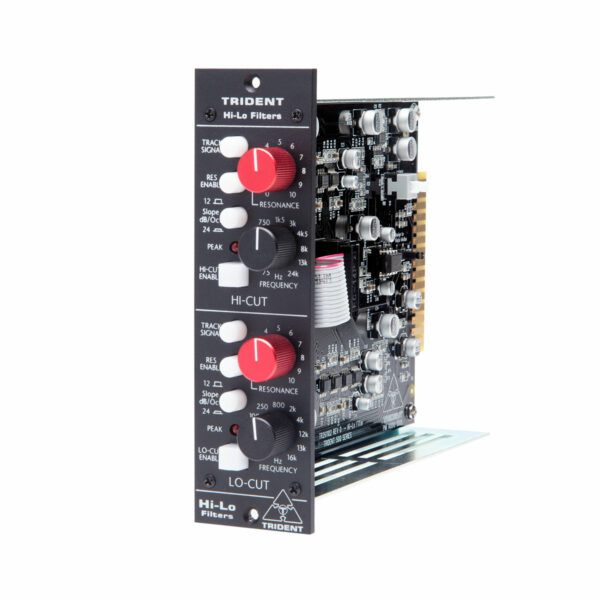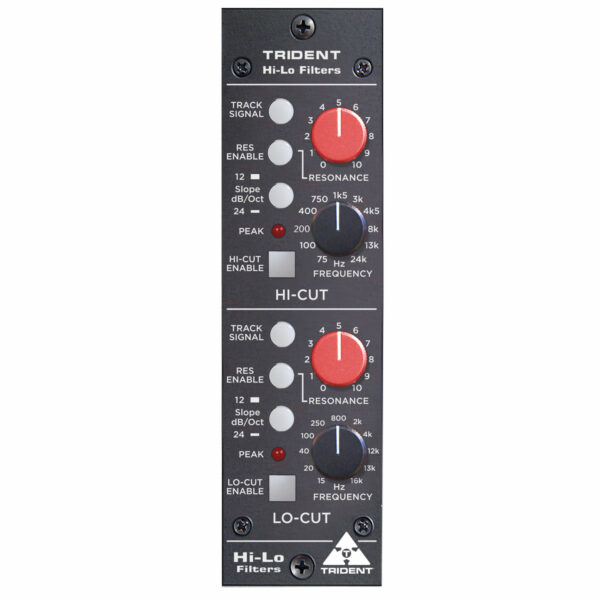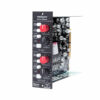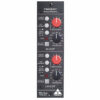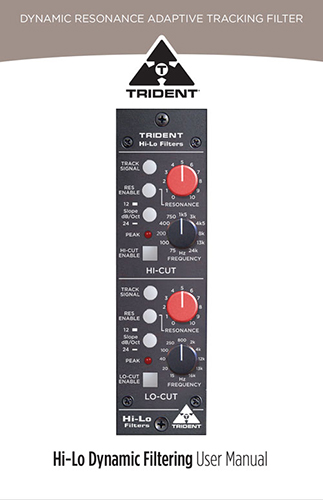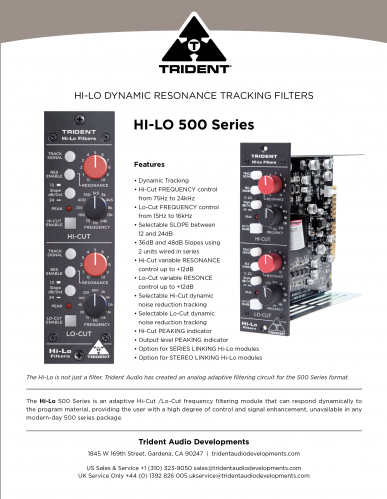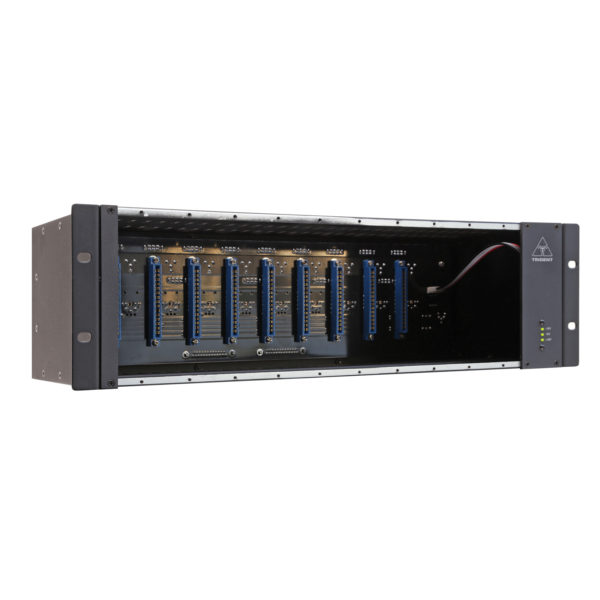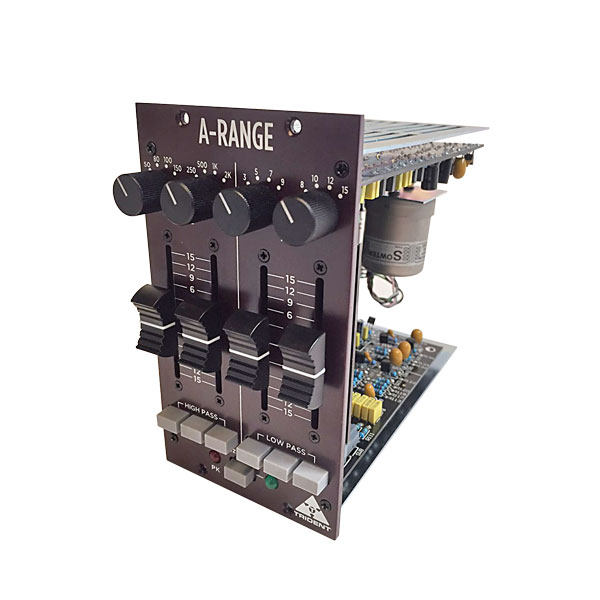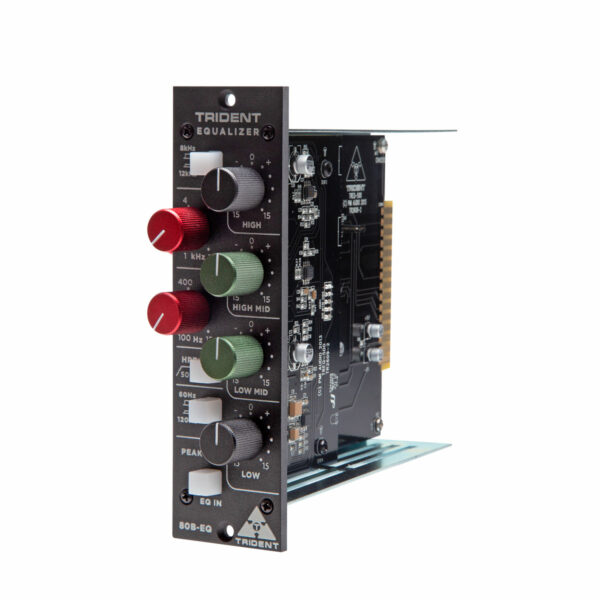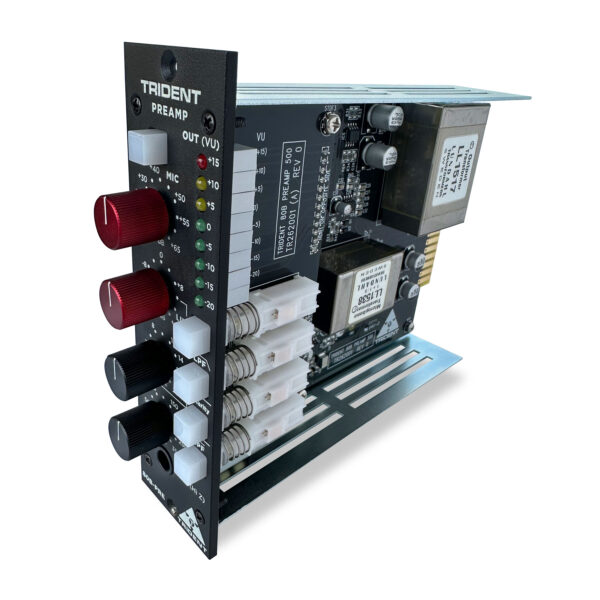- Overview
- Features
- Specifications
- Literature
- Warranty
ATTENTION: For all International orders please email us for better freight options at sales@tridentaudiodevelopments.com
Usually Ships in 48 Hours or Less
Hi-Lo Dynamic Filtering.
The Hi-Lo is not just a filter. Trident Audio has created an analog adaptive filtering circuit for the 500 Series format.
The Trident Hi-Lo, an adaptive Hi-Cut/Lo-Cut frequency filtering module that responds dynamically to program material, providing a high degree of control and signal enhancement, unavailable in any modern-day 500 series package.
The Hi-Cut
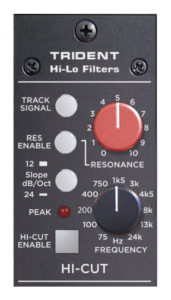
This is a sweepable low pass filter with unity gain in the selected passband and a selectable (12dB per octave or 24dB per octave) roll-off outside the passband. The cutoff frequency can be set from 75Hz to 24kHz.
In addition, a RESONANCE control can be switched into circuit, to introduce a resonant peak at the selected cutoff frequency. The size of this peak, which is dependant on the elected frequency selected on the front panel, can be varied from zero to approximately +12dB. At maximum setting, RESONANCE stops just short of self-oscillation.
A HI-CUT ENABLE switch allows each individual frequency band or filter to be assessed, while a red PEAK warning indicator will illuminate at approximately +16dBu, approximately 12dBu below clipping. To allow adequate headroom, avoid boosting the signal by more than an amount which just causes this LED to flash on occasional peaks.
Hi-Cut Dynamic Tracking
Using the TRACK SIGNAL function enables the Hi-Cut filter to be used for dynamic noise reduction. This is a technique that relies on the psychoacoustic effect of ‘masking’, in which a louder signal will cover up a quieter signal of the same frequency. In this mode, the cutoff frequency tracks dynamically the high frequency content of the music, with the FREQUENCY control setting the frequency to which the filter will close down in the absence of any high-frequency content.
With a noisy signal applied (e.g. from analog tape or other material with a high background noise content), start with the FREQUENCY control at maximum (fully clockwise) and back off the control until the noise just disappears.
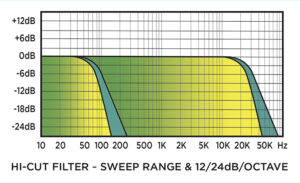
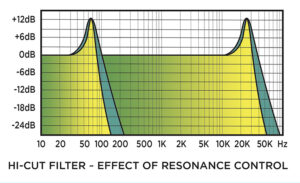
Use of higher resonant settings will result in the movement of the filter becoming audible and indeed, combined with the lower settings of the FREQUENCY control, this can be the basis of some unique special effects.
Further possibilities
The sweep range of the Hi-Cut filter is extremely wide, from effectively subsonic, right up to full audible bandwidth. This suggests the possibility of fading tracks in and out, not in the amplitude domain as is usual, but in the frequency domain.
The Lo-Cut
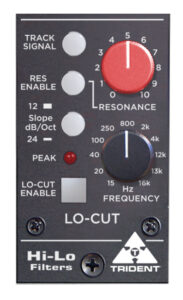
This is a sweepable high pass filter with unity gain in the selected passband and selectable (12dB per octave or 24dB per octave) roll-off outside of the passband. The cutoff frequency can be set manually, anywhere from 15Hz to 16kHz.
In addition, a RESONANCE control can be switched into the circuit, to introduce a resonant peak at the selected cutoff frequency. The size of this peak, which is dependant on the elected frequency selected on the front panel, can be varied from zero to approximately +12dB. At maximum setting, RESONANCE stops just short of self-oscillation.
A LOW-CUT ENABLE switch allows each individual frequency band or filter to be assessed, while a red PEAK warning indicator will illuminate at approximately +16dBu, approximately 12dBu below clip-ping. To allow adequate headroom, avoid boosting the signal by more than an amount which just causes this LED to flash on occasional peaks.
Lo-Cut Dynamic Tracking
Using the TRACK SIGNAL function, enables the Lo-Cut filter to be used for a dynamic hum or rumble reduction. This is a technique that relies on the psychoacoustic effect of ‘masking’, in which a louder signal will cover up a quieter signal of the same frequency. In this mode, the cut-off frequency tracks dynamically the low frequency content of the music, with the FREQUENCY control setting the frequency to which the filter will open up in the absence of any low-frequency content.
With a noisy signal applied (e.g. from a record deck or other material with a high background noise content), start with the FREQUENCY control at minimum (fully anticlockwise) and advance the control until the hum or rumble just disappears.
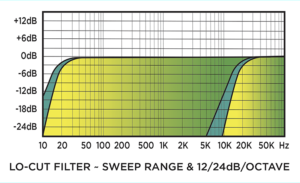
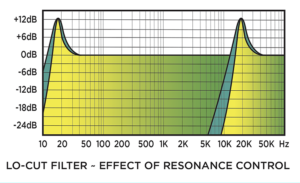
In practice, this technique demands a trade-off between noise reduction and loss of some low-frequency content of the program material. However, using the steepest (24dB per octave) slope maximizes the amount of low-frequency content retained. In addition, discreet use
of the RESONANCE control to introduce a small peak of a few dB at the cutoff frequency can psychoacoustically enhance the apparent bandwidth of the filtered signal. Use of higher resonant settings will result in the movement of the filter becoming audible and indeed, combined with higher settings of the FREQUENCY control, this can be the basis of some unique effects.
Further possibilities
The sweep range of the Lo-Cut filter is extremely wide, from effectively ultrasonic to right down to full audio bandwidth. This suggests the possibility of fading tracks in and out, not in the amplitude domain as usual, but in the frequency domain.
Hi-Lo Peak Indicators
The Trident Hi-Lo includes LED peak indicators on the outputs of both the Hi-Cut filter section and the Lo-Cut filter section. Since the filters are in series (the Hi-Cut circuitry before the Lo-Cut), the Hi-Cut Peak LED monitors the Hi-Cut filter stage only, and the Lo-Cut Peak LED monitors to signal thru both stages, and as such, the output of the unit. This gives the most flexibility for clip monitoring in the unit. The Output of the Hi-Lo can drive approximately 27.5 dB into a 600 Ohm load. The clip levels are approximately 12 dB below the actual signal Clip (so we have this occur at +16dBu) and allow for tweaks in resonance which may exceed that but allow for headroom after the clip indicator has just reached active.
It should also be noted, that if neither the Hi-Cut or Lo-Cut switches are enabled, the peak LED indicators are actively monitoring the incoming signal level.
Dynamic Linking Linked Stereo Tracking
The Trident Hi-Lo module also offers the option of linked stereo tracking when paired with a second Trident Hi-Lo module. Ordinarily, most 500 Series racks offer paired slots by default. The Trident Hi-Lo provides an on-board stereo link switch (S9) for use in this instance. With both modules, stereo link switches selected to on, and the modules fitted in the pre-paired slots, the modules are now paired together.
By enabling both Hi-Lo modules TRACK SIGNAL switches, and setting the FREQUENCY controls to identical positions, the left and right signals are now summed together, and the automatic tracking follows both the left and right signal sources.
When using a 500 Series rack with selectable stereo pairing on the rear of the rack, such as with the Trident Deca-Dent, by releasing the on-board stereo link switches, both modules can be used as separate mono units without the need to access the rear of the rack.
API Radial Workhorse
An onboard jumper is available for use when the Trident Hi-Lo is used in conjunction with the API Radial Workhorse. When selected, this allows the Hi-Lo to send its output to the Workhorse mix bus (pin 11), which is fed to the Workhorse mixer section. This can be used in conjunction with the on-board stereo link switch, thus enabling stereo use on the Workhorse.
Up to 48dB Per Octave Slope (Wired In Series)
When two Hi-Lo modules are connected in series, slopes of 12, 24, 36, and 48dB can be achieved, in any combination, by selecting the appropriate SLOPE buttons on the front of each Hi-Lo module. For example, by engaging both of the Hi-Lo modules Hi-Cut filters, and setting both modules to 24dB slope, the program material will be subject to a 48dB slope. By adjusting one of the Hi-Cut filters to 12dB, the program material will be subject to a 36dB slope.
The introduction of a third Hi-Lo in series with the first two Hi-Lo modules, would provide for yet steeper slopes, again in increments of 12dB. If fact, because they can be connected in series, you’re only limited by the number of Hi-Lo’s that you have to hand.
Features
- Dynamic Tracking
- Hi-Cut FREQUENCY control from 75Hz to 24kHz
- Lo-Cut FREQUENCY control from 15Hz to 16kHz
- Selectable SLOPE between 12 and 24dB
- 36dB and 48dB Slopes using 2 units wired in series
- Hi-Cut variable RESONANCE control up to +12dB
- Lo-Cut variable RESONANCE control up to +12dB
- Selectable Hi-Cut dynamic noise reduction tracking
- Selectable Lo-Cut dynamic noise reduction tracking
- Hi-Cut PEAKING indicator
- Output level PEAKING indicator
- Option for SERIES LINKING Hi-Lo modules
- Option for STEREO LINKING Hi-Lo modules
Specifications
Input Impedance 10 kilohms
Max Input +27dBu
Max Output +27dbu (Into 600ohms)
Distortion (+10dBu Out) 0.0031% (20Hz to 20kHz)
(Hi Enabled Max Freq)
(Lo Enabled Min Freq)
Distortion (+20dBu Out) 0.0069% (20Hz to 20kHz)
Frequency Response 15Hz to 60kHz (-3dB)
Noise (20Hz to 20kHz bandwidth limited)
No Filters in circuit (Residual Noise) -95dBu
High Cut Enabled
Freq Max -83.5dBu
Freq Min -90dBu
Freq Max – 24dB/Oct Slope Enabled -80dBu
Freq Min – 24dB/Oct Slope Enabled -90dBu
Freq Max – Res Enabled, Resonance Min -83.5dBu
Freq Max – Res Enabled, Resonance Max -72dBu
Freq Max – 24dB, Res Enabled, Res Max -71dBu
Freq Min – Res Enabled, Resonance Min -90dBu
Freq Min – Res Enabled, Resonance Max -90dBu
Freq Min – 24dB, Res Enabled, Res Max – 90dBu
Low Cut Enabled
Freq Max -83dBu
Freq Min -86dBu
Freq Max – 24dB/Oct Slope Enabled -83dBu
Freq Min – 24dB/Oct Slope Enabled -90dBu
Freq Max – Res Enabled, Resonance Min -84dBu
Freq Max – Res Enabled, Resonance Max -72dBu
Freq Max – 24dB, Res Enabled, Res Max -73dBu
Trident Electronics Warranty
Trident Audio Developments Limited Warranty Statement
The following outlines the warranty periods for all Trident Analogue electronics. All warranty service requires Proof of Purchase. Proof of purchase is the original Bill of Sale or Sales Invoice from an authorized dealer.
Trident Audio Developments electronics are covered by a limited warranty against defects in materials and workmanship (parts and labor) for a period of One (1) Year from the date the unit is sold to the Dealer or original purchaser only.
Acceptable registration is met by registering online – click here
The terms and conditions of this limited warranty are:
- The warranty applies to Trident Audio Developments Electronics purchased from Trident Audio or authorized Trident Audio dealers.
- The warranty covers any defects in materials and workmanship and is limited to the repair or replacement of the original registered product. In its sole discretion, Trident may either repair or replace the product with a product of the same model or replace the product with a new model of a similar specification when the same model is no longer available.
- The warranty does not cover any of the following: damage caused by the user: spillages or moisture damage; neglect, abuse, or misuse, including but not limited to the failure to use the product(s) for its normal purpose in accordance with the manufacturer’s instructions for use. Failure to properly maintain the product in accordance with the manufacturer’s instructions, and/or the failure to use the products in accordance with the manufacturer’s specifications; normal wear and tear; use of products with incompatible or faulty equipment; unauthorized modifications; repairs conducted by unauthorized persons or service center’s; the model and/or serial number is altered, removed or made illegible; accidents; acts of God or any cause beyond the control of Trident Audio Developments. It does not cover damage caused by connecting to an improper power voltage supply, cosmetic defects, such as paint finish, and general wear and tear, as well as certain consumables not covered under warranty such as fuses, faders, pots, switches, and meter bulbs. Mechanical components including but are not limited to a consumable item; potentiometers, faders, and switches are covered by a 90-day warranty. Failure to maintain, damage; neglect, abuse, or misuse of any mechanical components in this time will result in a void warranty. Trident recommends regular service of the product and in particular; regular service of the mechanical components such as potentiometers and faders.
- The warranty is applicable to the original purchaser throughout the warranty period as stated above or until the original owner resells the product. If a unit is received for warranty repair, and after complete examination and testing, no problem is found with the unit, the customer will be charged for time labor plus return shipping costs, presuming initial user error falsely caused the unit to be determined faulty.
- The warranty does not affect any statutory rights the original purchaser may have in accordance with the law applicable in the jurisdiction where the product was purchased, or any rights the original purchaser may have against the authorized dealer pursuant to their original purchase agreement. This warranty gives you specific legal rights and you may also have other rights, which vary from state to state, and or country to country.Any claim pursuant to this warranty from the date of purchase of any Trident Audio Developments product must be returned, together with the original proof of purchase, to the authorized Trident Audio dealer that sold the product, or to the Trident Audio service center in the USA or our UK service center. All returns to Trident Audio, or any Trident Audio Service Center must be in the original packing, accompanied by the issued Repair Authorization, and must be shipped to the address specified on the Return Authorization via insured freight at the customer’s own expense. Factory original packaging can be ordered from Trident Audio, Inc. Customer will be charged for new factory original packaging if the customer fails to ship product to Trident Audio in the original factory packaging. Trident Audio will not pay for express or overnight delivery.
- Once the product has been received, the authorized Trident Audio service center will assess the warranty claim and arrange to either repair or replace it in accordance with the warranty procedure prescribed by Trident Audio for their authorized service center network. The warranty replacement will be conducted by the authorized Trident Audio service center as promptly as possible and within a reasonable time from the date of submission of the warranty claim. In all circumstances, a claimant under this warranty will be liable for all costs in delivering their Trident Audio brand product to the authorized service center for warranty replacement and for all costs in collecting the repaired/replacement Trident Audio product from that authorized Trident Audio service center. Trident Audio service center may waive the cost of return shipping after full inspection to determine the cause of the warranty.
- Trident Audio will not accept any warranty replacement without the original proof of purchase of the Trident Audio product, and without the registration of the Trident Audio product within 30 days of purchase by mail, or online. It is the original purchaser’s responsibility to keep the original proof of purchase or copy safe at all times, as Trident Audio is not obliged to provide a replacement of the original proof of purchase.
- The warrantor assumes no liability for property damage or any other incidental or consequential damage whatsoever which may result from the failure of this product.
- A Trident Audio product that was not purchased through an authorized and legitimate sales channel is considered “Grey Market”. Warranties for Trident Audio Products purchased outside the USA will be covered by its Trident Audio UK Service Center. Trident Audio product originally sold to the USA market and consequently resold overseas forfeits its warranty. “Grey Market” purchases are not covered by any warranty. In the case that a Trident Audio Product must be returned, it should be returned to the original place of purchase, or the Trident Audio factory, with a proper return authorization. Returns from outside the USA, the customer shall adhere to specific shipping, customs, and commercial invoicing instructions given with the Return Authorization. Trident Audio will not be responsible for transportation costs or customs fees related to any importation or reexportation charges whatsoever.
- Trident Audio shall not be liable for damages in excess of the purchase price of the Trident Audio product arising out of the use or inability to use the Trident Audio product.
Governing Laws
Any dispute, controversy or claim arising out of or relating to this Agreement shall be decided by arbitration in Los Angeles, California, in accordance with the rules of the American Arbitration Association (the “Association) then in effect. Any award rendered by the Association shall be final, binding and not subject to appeal, and may be enforced by any court of competent jurisdiction.
For Tech Support and Repair Authorization, please contact: US Service & Sales 1845 W. 169th Street Gardena, CA 90247 at +1 (310) 323-9050 or sales@tridentaudiodevelopments.com
Trident Audio Developments is a registered trademark of PMI Audio Group
©2010 PMI Audio GroupFeatures and specifications are subject to change without notice.

Plug-in Features and Controls
1. LOUD
A color-coded (red) knob provides controls for loudness compensation within the range of -6 to +6 (cut/boost intensity level). Click the knob and drag up to increase the value and drag down to decrease. Alternatively, double-click on the rotary knob to manually enter a value.
2. LOUD BYPASS
Press the IN button above the LOUD control to enable (backlight on) or disable (backlight off) the loudness compensation function.
3. TILT
A color-coded (black) knob provides controls for tilt equalization within the range of -6 to +6 (cut/boost intensity level). Click the knob and drag up to increase the value (favoring high frequencies) and drag down to decrease (favoring low frequencies). Alternatively, double-click on the rotary knob to manually enter a value.
4. TILT BYPASS
Press the IN button above the TILT control to enable (backlight on) or disable (backlight off) the Tilt equalization function.
5. HIGH PASS FILTER – Slope (dB)
A color-coded (green) rotary knob sets the high pass filter slope in dB per octave, within the range of 0 dB/Off (Off=default) to 18 dB. Click the knob and drag up to increase the value and drag down to decrease. Alternatively, double-click on the rotary knob to manually enter a value.
6. HIGH PASS FILTER – Frequency (Hz)
A color-coded (green) rotary knob sets the high pass corner frequency within the range of 100 Hz to 400 Hz. Click the knob and drag up to increase the frequency and drag down to decrease. Alternatively, double-click on the rotary knob to manually enter a value.
7. HIGH PASS FILTER – Bypass
Press the IN button above the HPF controls to enable (backlight on) or disable (backlight off) the high pass filter function.
8. LOW PASS FILTER – Slope (dB)
A color-coded (green) rotary knob sets the low pass filter slope in dB per octave, within the range of 0 dB/Off (Off=default) to 18 dB. Click the knob and drag up to increase the value and drag down to decrease. Alternatively, double-click on the rotary knob to manually enter a value.
9. LOW PASS FILTER – Frequency (Hz)
A color-coded (green) rotary knob sets the low pass filter corner frequency within 4 kHz to 15 kHz. Click the knob and drag up to increase the frequency and drag down to decrease. Alternatively, double-click on the rotary knob to manually enter a value.
10. LOW PASS FILTER – Bypass
Press the IN button above the LPF controls to enable (backlight on) or disable (backlight off) the low pass filter function.
11. SATURATION
A color-coded (black) rotary knob sets the saturation enhancement level within the range of 0 (MIN) and 100 (MAX). Click the knob and drag up to increase the value and drag down to decrease. Alternatively, double-click on the rotary knob to manually enter a value.
12. SATURATION Bypass
Press the IN button above the SATURATION control to enable (backlight on) or disable (backlight off) the saturation enhancement function.
13. OUTPUT
A color-coded (red) rotary knob sets the output gain level within the range of -16 dB to +16 dB. Click the knob and drag up to increase the value and drag down to decrease. Alternatively, double-click on the rotary knob to manually enter a value.
14. POLARITY (Ø)
Press the Ø button above the OUTPUT control to invert the signal polarity (backlight on) or maintain the current polarity (backlight off).
15. METERING
Press the ON button above the VU meter to enable (backlight on) or disable (backlight off) the VU and PPM metering functions.
16. 0 VU CALIBRATION
Use the -8.0 or -18.0 radio buttons above the VU meter to toggle between a 0 VU calibration level of -8.0 dBFS or -18 dBFS respectively. NOTE: Calibration applies to the VU meter only; the PPM meter range is mapped directly to peak values between -20 and +3 dBFS.
iLok License Manager is used for software activation (2 activations per license). For more information about iLok License Manager, please visit ilok.com.
